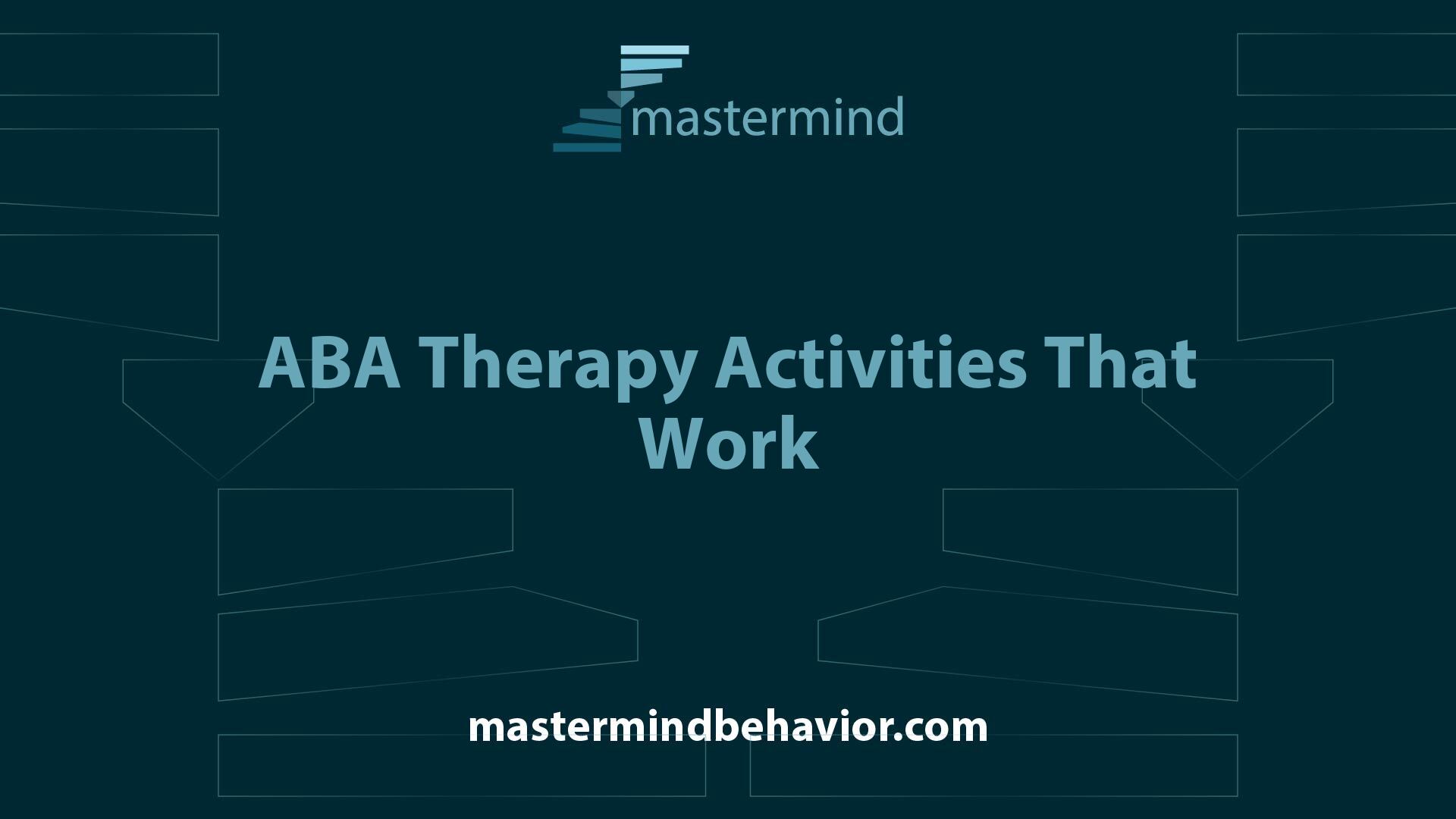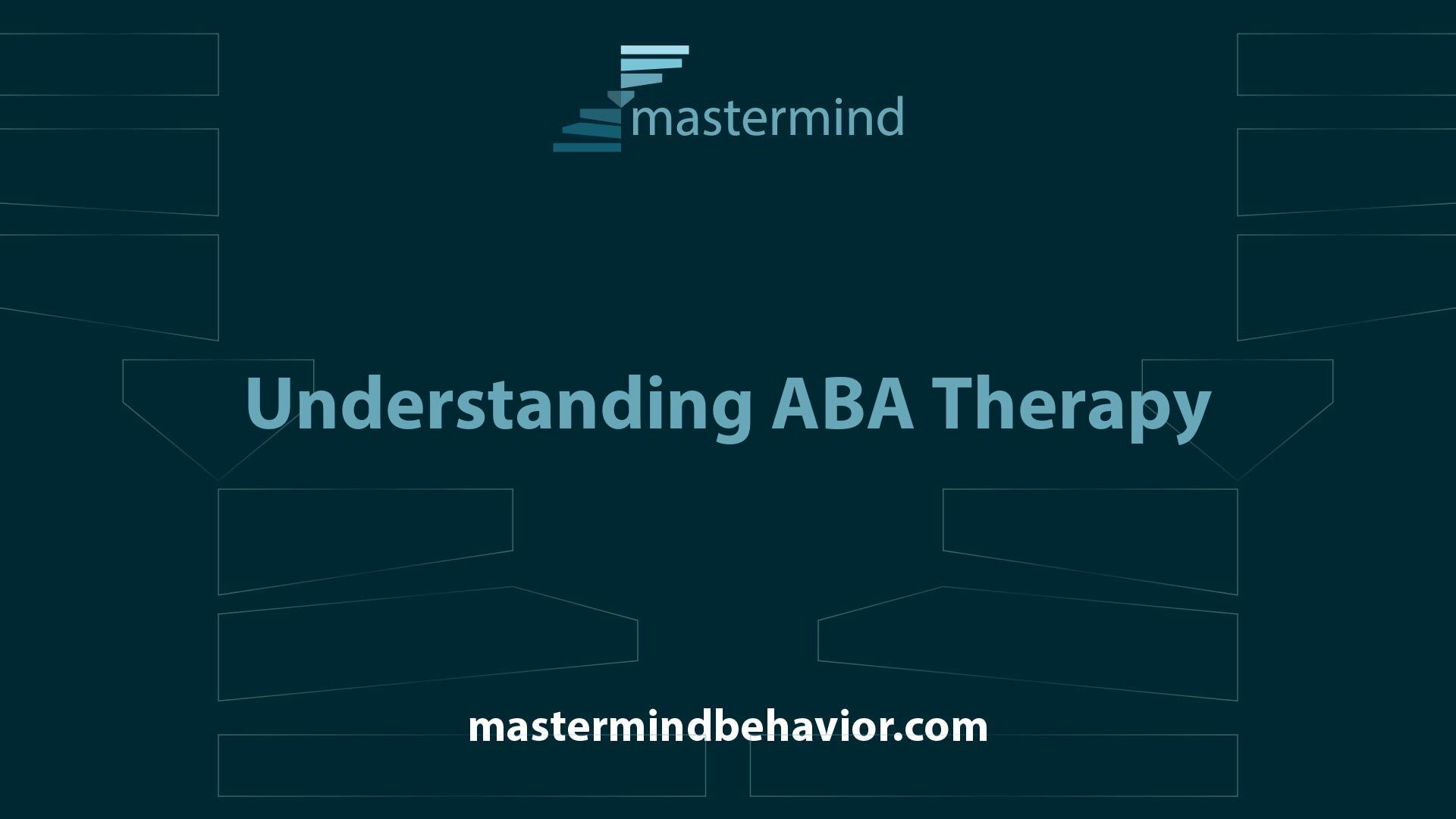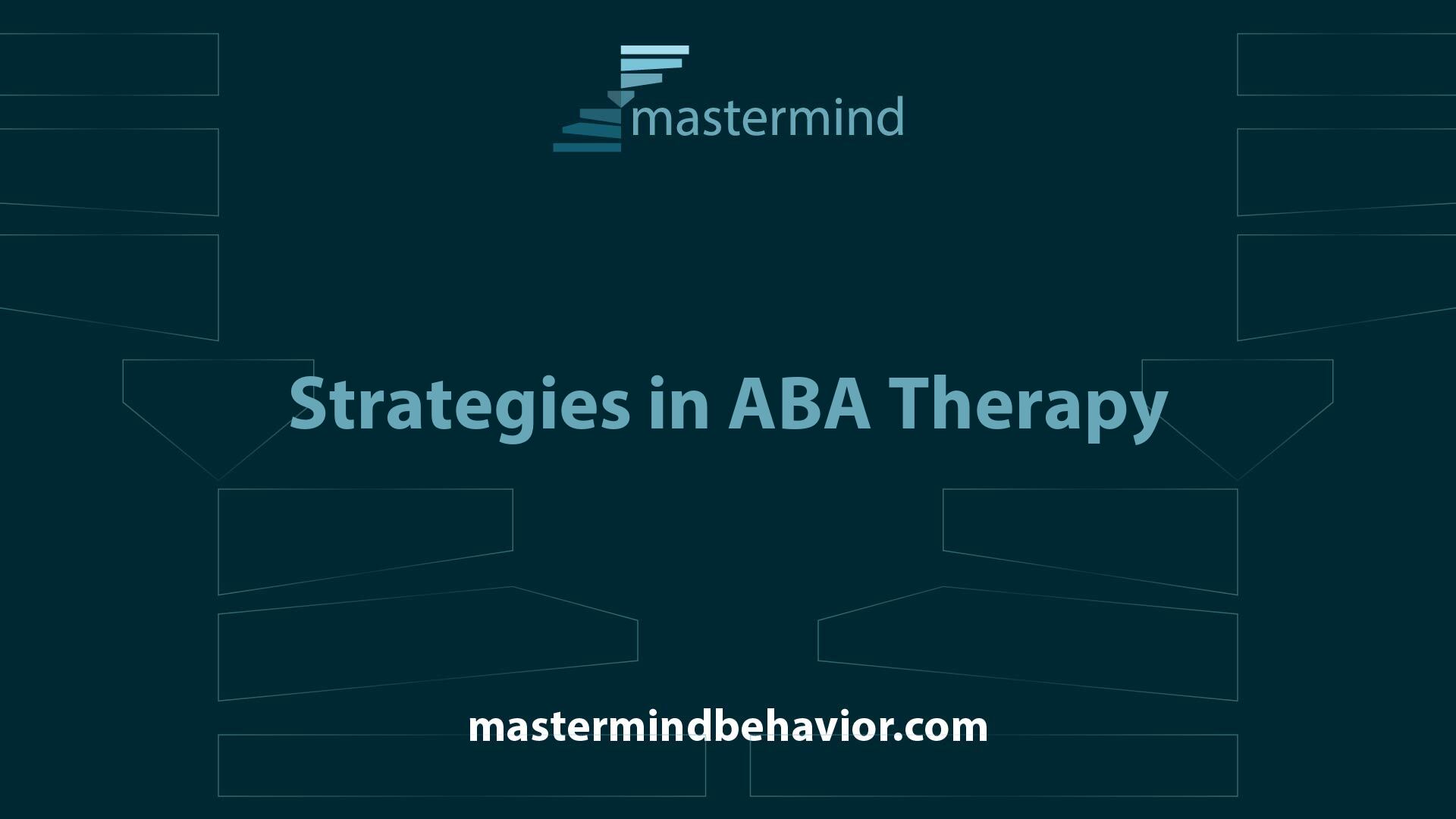ABA Therapy Activities That Work


Understanding ABA Therapy
Applied Behavior Analysis (ABA) therapy is a systematic approach to understanding and improving behavior in individuals, particularly those with developmental disorders such as autism. This section delves into the functions of behavior in ABA and the significance of teaching replacement behaviors.
Functions of Behavior in ABA
In ABA therapy, understanding the functions of behavior is crucial for effectively developing therapeutic interventions. The four common functions of behavior include:
By identifying the function of a behavior, therapists can create behavior intervention plans that address the underlying cause, fostering positive change and skill development. This tailored approach enhances the effectiveness of ABA therapy activities.
Function of BehaviorDescriptionEscape or AvoidanceBehavior to avoid unpleasant situationsAttention-SeekingBehavior to gain attention from othersAccess to Tangible ItemsBehavior to obtain desired objects or activitiesSensory StimulationBehavior for sensory input or output
Importance of Replacement Behaviors
A core component of ABA therapy is the teaching of appropriate replacement behaviors. These are behaviors that serve similar functions to the problem behavior but are more adaptive and socially acceptable. For example, if a child engages in tantrums to gain attention, teaching them to ask for help or use a communication device can serve as an effective replacement behavior.
Focusing on replacement behaviors helps individuals meet their needs without resorting to problematic actions. This not only supports smoother social interactions but also encourages the development of essential life skills. Resources such as essential speech and ABA therapy can provide additional support in facilitating these communication skills.
In summary, understanding the functions of behavior and prioritizing the teaching of replacement behaviors are foundational to successful ABA therapy. This structured approach allows therapists to create targeted interventions that lead to meaningful outcomes for individuals.

Strategies in ABA Therapy
Strategies are critical in ABA therapy to ensure effective interventions and support for individuals. Three primary strategies include reinforcement techniques, addressing challenging behaviors, and continuous assessment.
Reinforcement Techniques
Reinforcement strategies are a fundamental component of behavior intervention in ABA therapy. By reinforcing positive and appropriate behaviors, individuals are motivated to continue engaging in those behaviors. Reinforcement can take various forms, including tangible rewards, praise, social attention, or access to preferred activities.
Type of ReinforcementDescriptionTangible RewardsPhysical items given for positive behavior, such as toys or treats.PraiseVerbal acknowledgment of positive actions.Social AttentionInteraction from peers or caregivers as a reward.Preferred ActivitiesAllowing access to enjoyable activities post-behavior.
Utilizing diverse reinforcement methods not only encourages desired behaviors but also helps build a supportive environment for learning.
Addressing Challenging Behaviors
To effectively address challenging behaviors in ABA therapy, it is crucial to identify the function of the behavior. Key steps involve conducting a Functional Behavior Assessment (FBA), observing and analyzing behavior, and using functional analysis. Understanding the underlying reason for a behavior enables therapists to tailor interventions effectively.
A structured approach to identifying function may include:
StepDescriptionConduct FBAAssess the individual's behaviors and their context.ObserveMonitor the individual in various settings to gather information.AnalyzeDetermine patterns and triggers associated with the behavior.
By employing these techniques, ABA therapists can create targeted interventions aimed at reducing challenging behaviors while promoting positive alternatives.
Continuous Assessment in ABA
ABA therapists continuously assess the effectiveness of behavior interventions and make modifications as necessary. They use data to refine and adapt intervention plans, ensuring they remain effective and address the individual's goals and needs.
The process of continuous assessment involves:
Assessment ComponentPurposeData CollectionGather information on behavior before, during, and after interventions.Progress MonitoringRegularly evaluate the individual's progress towards set goals.Plan AdjustmentModify strategies based on data to enhance effectiveness.
This ongoing evaluation is essential to ensure the interventions align with the individual's changing needs and promote optimal outcomes in their ABA therapy journey. For more detailed ABA therapy activities, refer to related topics in our article.
Sensory Social Routines in ABA
In the realm of ABA therapy, sensory social routines play a vital role in assisting children with Autism Spectrum Disorder (ASD). These routines are structured interactions that merge sensory experiences with social learning, ultimately facilitating ongoing development in various skill areas.
Facilitating Development
Sensory social routines offer profound benefits for children facing sensory processing challenges. By integrating sensory activities within social interactions, these routines improve both sensory regulation and communication skills (Chicago ABA Therapy). The structured nature of these activities helps children navigate social situations with greater ease and reduces anxiety levels during play.
Key Benefits of Sensory Social Routines
BenefitDescriptionSensory IntegrationEnhances the child's ability to process and respond to sensory information effectively.Social Skills DevelopmentPromotes interactions with peers, increasing comfort and confidence in social settings.Communication SkillsAids in expressing needs and thoughts, improving overall social communication.
The predictability created through these routines makes children more comfortable exploring play and engaging with others, which is essential for building social competencies. Over time, children can learn to initiate and complete activities independently.
Individualized Approaches
Every child with ASD has unique needs and responses to sensory experiences. Therefore, individualized approaches to implementing sensory social routines are essential. Therapists often tailor activities based on the child's specific sensory preferences and sensitivities, ensuring that exercises remain engaging and beneficial.
Recognizing these individual differences allows for the development of targeted strategies that can further enhance skill acquisition. For families seeking more personalized support, resources related to in home ABA therapy and local program options like best ABA therapy near me can provide additional guidance.
By understanding the importance of sensory social routines, families can better support their children's development in both sensory integration and social contexts. A well-structured approach not only helps in learning but also enhances the overall quality of life for children with ASD.
Structured Play Activities
Structured play activities offer significant advantages for autistic children. Such activities create a focused environment where children can develop essential social and communication skills.
Benefits for Autistic Children
Structured play can aid autistic children in acquiring various play skills such as sharing, taking turns, and seeing things from other people's perspectives. These activities help children learn to interact with peers and boost their fine and gross motor skills as well as communication abilities. The predictability provided by structured play reduces anxiety and stress levels, allowing children to feel more comfortable when engaging in play and social interactions (Raising Children Network, Autism Awareness Centre).
The following table illustrates specific benefits of structured play activities for autistic children:
BenefitDescriptionSkill DevelopmentHelps learn sharing, taking turns, and social interaction skills.Motor Skills ImprovementSupports the development of fine and gross motor skills.Reduced AnxietyCreates predictability through structure, lowering anxiety and boosting confidence in social situations.Enhanced IndependenceWith practice, children may learn to start and finish activities on their own.Visual SupportsUtilizing visual aids can clarify the sequence of activities, making the play process easier to understand.
Enhancing Play Skills
To maximize the effectiveness of structured play, incorporating a clear beginning, middle, and end in activities is essential. Doing so grants children a simple framework to follow, which helps them know what to expect and how to participate. Utilizing visual supports, such as one-step visuals, enhances their understanding of the activity sequences and expected behaviors.
Certain resources, such as "Climbing Art Obstacles" and "Tasks Galore – Let’s Play," provide excellent visual guidance to break down tasks and give structured ideas for play. By engaging children in structured activities, they cultivate vital skills that can improve their quality of interaction and enjoyment in social situations, promoting overall developmental growth.
ABA Therapy Techniques
The effectiveness of ABA therapy heavily relies on specific techniques that support the learning and development of children. These techniques include data collection and analysis, personalized interventions, and generalizing learned skills.
Data Collection and Analysis
Data collection is fundamental in Applied Behavior Analysis (ABA) therapy, particularly for children diagnosed with autism spectrum disorder. It enables therapists to monitor progress, identify behavioral trends, and determine effective strategies. Common tracking methods include:
MethodDescriptionFrequency CountsRecords how often a specific behavior occurs.Duration MeasuresMeasures how long a behavior lasts during an observation.Interval RecordingObserves whether a behavior occurs within predetermined time intervals.
Using these methods, therapists can analyze behaviors accurately, allowing for informed decisions regarding intervention strategies.
Personalized Interventions
Personalized interventions are an essential aspect of effective ABA therapy. These interventions are developed through Functional Behavior Assessment (FBA), which examines a child's behavior to understand the underlying functions driving it. This tailored approach enables practitioners to create targeted strategies that cater to the specific needs of each child. Recognizing that each child may respond differently to various techniques is critical for success.
Generalizing Learned Skills
Generalizing skills acquired through ABA therapy is crucial for children with autism to apply their learning across various contexts. Generalization strategies ensure that learned abilities are not limited to a specific setting but can be adapted for real-life situations. Techniques for promoting generalization include:
By focusing on generalizing learned skills, ABA therapy fosters more positive outcomes in everyday life for children.
Utilizing these ABA therapy techniques enhances the overall effectiveness of interventions, supporting children with autism in their growth and development. For parents seeking local services, resources like best aba therapy near me and in-home aba therapy can offer valuable options.
Promoting Social Skills
Promoting social skills is a fundamental component of ABA therapy. Through various strategies and techniques, individuals can learn and improve their social interactions, making meaningful connections with others.
Positive Reinforcement in ABA
ABA therapy effectively employs positive reinforcement methods to nurture and shape social skills. By rewarding children for exhibiting desired behaviors, this technique increases the likelihood that these behaviors will be repeated in the future. Rewards can include verbal praise, tokens, or preferred activities, tailored to suit the unique needs and preferences of each child. This promotes long-term behavior change and enhances social interaction (Empower Behavioral Health).
Type of Positive ReinforcementExampleVerbal Praise"Great job sharing your toys!"TokensEarning a token for participating in group activitiesPreferred ActivitiesChoosing a favorite game after demonstrating appropriate social behavior
Teaching Strategies
Behavior analysis serves as the foundation for ABA therapy, focusing on the interplay between antecedents, behavior, and consequences. By understanding these elements, practitioners can develop targeted interventions that promote positive behavioral change. ABA therapy tailors its strategies according to specific social deficits, thus enhancing social skills effectively. Techniques may include modeling appropriate interactions, role-playing, and social stories, encouraging children to practice and master social scenarios.
Teaching StrategyDescriptionModelingDemonstrating appropriate social interactions for children to imitateRole-PlayingPracticing social scenarios in a controlled environmentSocial StoriesShort narratives that describe social situations and expected behaviors
Enhancing Social Abilities
Fostering social abilities through positive reinforcement is a key technique used in ABA therapy, particularly for children with Autism Spectrum Disorder (ASD). When children receive immediate rewards or praise following the demonstration of desired behaviors, it reinforces their understanding of appropriate social interactions. This method not only encourages repetition of good behavior but also helps children learn to navigate social situations more confidently (Hidden Talents ABA).
Social AbilityMethod of EnhancementCommunication SkillsEncouraging verbal exchanges through play-based activitiesSharing and Turn-TakingUsing games that require cooperative play and turn-takingUnderstanding Social CuesTeaching recognition of facial expressions and body language through interaction
Incorporating these positive reinforcement techniques, teaching strategies, and focused approaches in ABA therapy can lead to significant improvements in social skills for children. By individualizing these activities, practitioners can ensure that each child receives the support they need to thrive socially.
Recent articles

How Behavioral Therapy Helps Improve Peer Relationships in Children
Building Bridges: The Role of Behavioral Therapy in Enhancing Children's Social and Peer Relationships

The importance of goal-setting in ABA therapy
Maximizing Outcomes Through Strategic Goal-Setting in ABA Therapy

How to Create a Structured Environment for ABA Therapy at Home
Building a Supportive Home for Autism Therapy Success

The impact of peer modeling on skill development
Harnessing Peer Influence to Enhance Learning and Development

How to Teach Conflict Avoidance Strategies to Children with Autism
Fostering Harmony: Strategies for Teaching Conflict Prevention to Children with Autism

How to Foster Independence in Children with Autism
Empowering Growth: Strategies for Building Autonomy in Children with Autism


